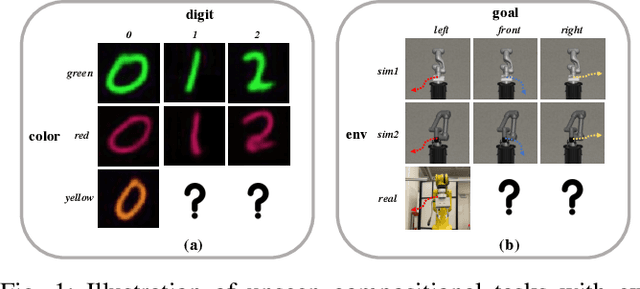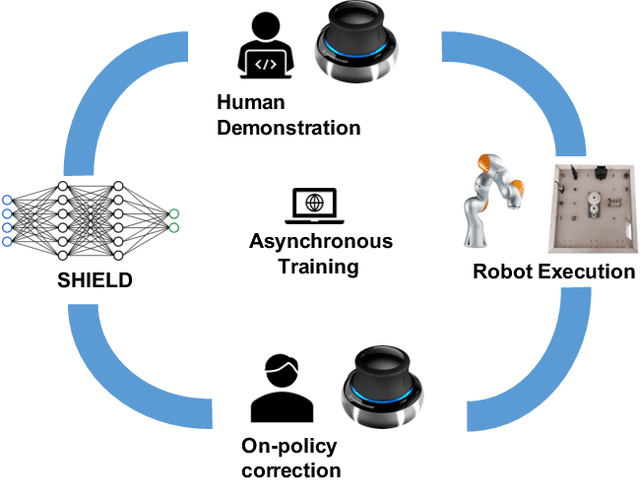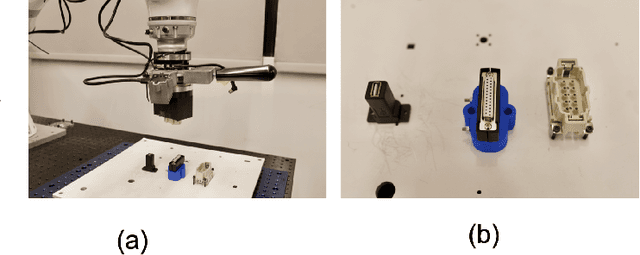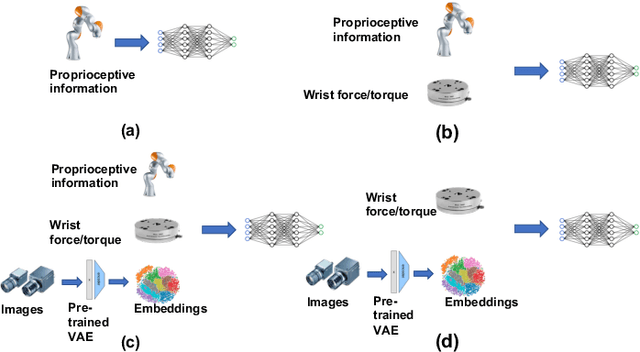Wenzhao Lian
SAGE: Scene Graph-Aware Guidance and Execution for Long-Horizon Manipulation Tasks
Sep 26, 2025Abstract:Successfully solving long-horizon manipulation tasks remains a fundamental challenge. These tasks involve extended action sequences and complex object interactions, presenting a critical gap between high-level symbolic planning and low-level continuous control. To bridge this gap, two essential capabilities are required: robust long-horizon task planning and effective goal-conditioned manipulation. Existing task planning methods, including traditional and LLM-based approaches, often exhibit limited generalization or sparse semantic reasoning. Meanwhile, image-conditioned control methods struggle to adapt to unseen tasks. To tackle these problems, we propose SAGE, a novel framework for Scene Graph-Aware Guidance and Execution in Long-Horizon Manipulation Tasks. SAGE utilizes semantic scene graphs as a structural representation for scene states. A structural scene graph enables bridging task-level semantic reasoning and pixel-level visuo-motor control. This also facilitates the controllable synthesis of accurate, novel sub-goal images. SAGE consists of two key components: (1) a scene graph-based task planner that uses VLMs and LLMs to parse the environment and reason about physically-grounded scene state transition sequences, and (2) a decoupled structural image editing pipeline that controllably converts each target sub-goal graph into a corresponding image through image inpainting and composition. Extensive experiments have demonstrated that SAGE achieves state-of-the-art performance on distinct long-horizon tasks.
FoAM: Foresight-Augmented Multi-Task Imitation Policy for Robotic Manipulation
Sep 29, 2024



Abstract:Multi-task imitation learning (MTIL) has shown significant potential in robotic manipulation by enabling agents to perform various tasks using a unified policy. This simplifies the policy deployment and enhances the agent's adaptability across different contexts. However, key challenges remain, such as maintaining action reliability (e.g., avoiding abnormal action sequences that deviate from nominal task trajectories), distinguishing between similar tasks, and generalizing to unseen scenarios. To address these challenges, we introduce the Foresight-Augmented Manipulation Policy (FoAM), an innovative MTIL framework. FoAM not only learns to mimic expert actions but also predicts the visual outcomes of those actions to enhance decision-making. Additionally, it integrates multi-modal goal inputs, such as visual and language prompts, overcoming the limitations of single-conditioned policies. We evaluated FoAM across over 100 tasks in both simulation and real-world settings, demonstrating that it significantly improves IL policy performance, outperforming current state-of-the-art IL baselines by up to 41% in success rate. Furthermore, we released a simulation benchmark for robotic manipulation, featuring 10 task suites and over 80 challenging tasks designed for multi-task policy training and evaluation. See project homepage https://projFoAM.github.io/ for project details.
Cable Routing and Assembly using Tactile-driven Motion Primitives
Mar 21, 2023Abstract:Manipulating cables is challenging for robots because of the infinite degrees of freedom of the cables and frequent occlusion by the gripper and the environment. These challenges are further complicated by the dexterous nature of the operations required for cable routing and assembly, such as weaving and inserting, hampering common solutions with vision-only sensing. In this paper, we propose to integrate tactile-guided low-level motion control with high-level vision-based task parsing for a challenging task: cable routing and assembly on a reconfigurable task board. Specifically, we build a library of tactile-guided motion primitives using a fingertip GelSight sensor, where each primitive reliably accomplishes an operation such as cable following and weaving. The overall task is inferred via visual perception given a goal configuration image, and then used to generate the primitive sequence. Experiments demonstrate the effectiveness of individual tactile-guided primitives and the integrated end-to-end solution, significantly outperforming the method without tactile sensing. Our reconfigurable task setup and proposed baselines provide a benchmark for future research in cable manipulation. More details and video are presented in \url{https://helennn.github.io/cable-manip/}
Prim-LAfD: A Framework to Learn and Adapt Primitive-Based Skills from Demonstrations for Insertion Tasks
Dec 02, 2022



Abstract:Learning generalizable insertion skills in a data-efficient manner has long been a challenge in the robot learning community. While the current state-of-the-art methods with reinforcement learning (RL) show promising performance in acquiring manipulation skills, the algorithms are data-hungry and hard to generalize. To overcome the issues, in this paper we present Prim-LAfD, a simple yet effective framework to learn and adapt primitive-based insertion skills from demonstrations. Prim-LAfD utilizes black-box function optimization to learn and adapt the primitive parameters leveraging prior experiences. Human demonstrations are modeled as dense rewards guiding parameter learning. We validate the effectiveness of the proposed method on eight peg-hole and connector-socket insertion tasks. The experimental results show that our proposed framework takes less than one hour to acquire the insertion skills and as few as fifteen minutes to adapt to an unseen insertion task on a physical robot.
Allowing Safe Contact in Robotic Goal-Reaching: Planning and Tracking in Operational and Null Spaces
Oct 31, 2022



Abstract:In recent years, impressive results have been achieved in robotic manipulation. While many efforts focus on generating collision-free reference signals, few allow safe contact between the robot bodies and the environment. However, in human's daily manipulation, contact between arms and obstacles is prevalent and even necessary. This paper investigates the benefit of allowing safe contact during robotic manipulation and advocates generating and tracking compliance reference signals in both operational and null spaces. In addition, to optimize the collision-allowed trajectories, we present a hybrid solver that integrates sampling- and gradient-based approaches. We evaluate the proposed method on a goal-reaching task in five simulated and real-world environments with different collisional conditions. We show that allowing safe contact improves goal-reaching efficiency and provides feasible solutions in highly collisional scenarios where collision-free constraints cannot be enforced. Moreover, we demonstrate that planning in null space, in addition to operational space, improves trajectory safety.
Zero-Shot Policy Transfer with Disentangled Task Representation of Meta-Reinforcement Learning
Oct 01, 2022



Abstract:Humans are capable of abstracting various tasks as different combinations of multiple attributes. This perspective of compositionality is vital for human rapid learning and adaption since previous experiences from related tasks can be combined to generalize across novel compositional settings. In this work, we aim to achieve zero-shot policy generalization of Reinforcement Learning (RL) agents by leveraging the task compositionality. Our proposed method is a meta- RL algorithm with disentangled task representation, explicitly encoding different aspects of the tasks. Policy generalization is then performed by inferring unseen compositional task representations via the obtained disentanglement without extra exploration. The evaluation is conducted on three simulated tasks and a challenging real-world robotic insertion task. Experimental results demonstrate that our proposed method achieves policy generalization to unseen compositional tasks in a zero-shot manner.
Symbolic State Estimation with Predicates for Contact-Rich Manipulation Tasks
Mar 04, 2022



Abstract:Manipulation tasks often require a robot to adjust its sensorimotor skills based on the state it finds itself in. Taking peg-in-hole as an example: once the peg is aligned with the hole, the robot should push the peg downwards. While high level execution frameworks such as state machines and behavior trees are commonly used to formalize such decision-making problems, these frameworks require a mechanism to detect the high-level symbolic state. Handcrafting heuristics to identify symbolic states can be brittle, and using data-driven methods can produce noisy predictions, particularly when working with limited datasets, as is common in real-world robotic scenarios. This paper proposes a Bayesian state estimation method to predict symbolic states with predicate classifiers. This method requires little training data and allows fusing noisy observations from multiple sensor modalities. We evaluate our framework on a set of real-world peg-in-hole and connector-socket insertion tasks, demonstrating its ability to classify symbolic states and to generalize to unseen tasks, outperforming baseline methods. We also demonstrate the ability of our method to improve the robustness of manipulation policies on a real robot.
You Only Demonstrate Once: Category-Level Manipulation from Single Visual Demonstration
Jan 30, 2022



Abstract:Promising results have been achieved recently in category-level manipulation that generalizes across object instances. Nevertheless, it often requires expensive real-world data collection and manual specification of semantic keypoints for each object category and task. Additionally, coarse keypoint predictions and ignoring intermediate action sequences hinder adoption in complex manipulation tasks beyond pick-and-place. This work proposes a novel, category-level manipulation framework that leverages an object-centric, category-level representation and model-free 6 DoF motion tracking. The canonical object representation is learned solely in simulation and then used to parse a category-level, task trajectory from a single demonstration video. The demonstration is reprojected to a target trajectory tailored to a novel object via the canonical representation. During execution, the manipulation horizon is decomposed into long-range, collision-free motion and last-inch manipulation. For the latter part, a category-level behavior cloning (CatBC) method leverages motion tracking to perform closed-loop control. CatBC follows the target trajectory, projected from the demonstration and anchored to a dynamically selected category-level coordinate frame. The frame is automatically selected along the manipulation horizon by a local attention mechanism. This framework allows to teach different manipulation strategies by solely providing a single demonstration, without complicated manual programming. Extensive experiments demonstrate its efficacy in a range of challenging industrial tasks in high-precision assembly, which involve learning complex, long-horizon policies. The process exhibits robustness against uncertainty due to dynamics as well as generalization across object instances and scene configurations.
CaTGrasp: Learning Category-Level Task-Relevant Grasping in Clutter from Simulation
Sep 19, 2021



Abstract:Task-relevant grasping is critical for industrial assembly, where downstream manipulation tasks constrain the set of valid grasps. Learning how to perform this task, however, is challenging, since task-relevant grasp labels are hard to define and annotate. There is also yet no consensus on proper representations for modeling or off-the-shelf tools for performing task-relevant grasps. This work proposes a framework to learn task-relevant grasping for industrial objects without the need of time-consuming real-world data collection or manual annotation. To achieve this, the entire framework is trained solely in simulation, including supervised training with synthetic label generation and self-supervised, hand-object interaction. In the context of this framework, this paper proposes a novel, object-centric canonical representation at the category level, which allows establishing dense correspondence across object instances and transferring task-relevant grasps to novel instances. Extensive experiments on task-relevant grasping of densely-cluttered industrial objects are conducted in both simulation and real-world setups, demonstrating the effectiveness of the proposed framework. Code and data will be released upon acceptance at https://sites.google.com/view/catgrasp.
Robust Multi-Modal Policies for Industrial Assembly via Reinforcement Learning and Demonstrations: A Large-Scale Study
Mar 23, 2021



Abstract:Over the past several years there has been a considerable research investment into learning-based approaches to industrial assembly, but despite significant progress these techniques have yet to be adopted by industry. We argue that it is the prohibitively large design space for Deep Reinforcement Learning (DRL), rather than algorithmic limitations per se, that are truly responsible for this lack of adoption. Pushing these techniques into the industrial mainstream requires an industry-oriented paradigm which differs significantly from the academic mindset. In this paper we define criteria for industry-oriented DRL, and perform a thorough comparison according to these criteria of one family of learning approaches, DRL from demonstration, against a professional industrial integrator on the recently established NIST assembly benchmark. We explain the design choices, representing several years of investigation, which enabled our DRL system to consistently outperform the integrator baseline in terms of both speed and reliability. Finally, we conclude with a competition between our DRL system and a human on a challenge task of insertion into a randomly moving target. This study suggests that DRL is capable of outperforming not only established engineered approaches, but the human motor system as well, and that there remains significant room for improvement. Videos can be found on our project website: https://sites.google.com/view/shield-nist.
 Add to Chrome
Add to Chrome Add to Firefox
Add to Firefox Add to Edge
Add to Edge